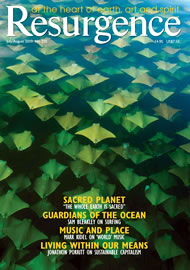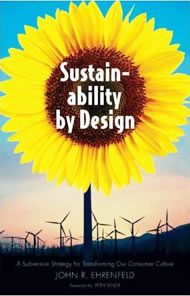TO BE CLEAR from the start, this is not a book primarily about designing technological solutions, however green. Much more fundamental, it is about a new, more appropriate language; a solid, reliable underpinning for all that follows in attempting to retrieve the true meaning of ‘sustainability’ and to build a fulfilling, ethical and lasting future upon it. In this context ‘by design’ means (mostly, but not wholly) a positive, intentional act and ‘sustainability’ means (and I quote author John Ehrenfeld’s new, distinctive definition) “the possibility that human and other life will flourish on the planet”.
Ehrenfeld’s view is that a new language of ‘being’ (rather than of ‘having’), should be intentionally embedded within all our activities, by design. We must set out on a journey into ideas that will germinate, not in a consumerist culture, but by establishing a completely different type of sustainability that grows naturally out of the more fertile soil of a “Culture of Being”. This is practical eco-philosophy.
Sustainability by Design is a bold, coherently argued book that expresses a heartfelt desire to regain right (sustainable) action through holistic thinking. Nevertheless it also promotes real possibilities such as zero waste. But why should this be a ‘subversive’ exercise? Perhaps, as an effective tactic, it is useful to hold a sense of the constructively subversive about thoughts that will rock, and eventually undermine, the prevailing mind-set – simply because it is currently so powerful and our addictions to it are so strong. A sense of the positively subversive is creatively stimulating, often exciting and ultimately effective. It encourages others to join in.
Einstein realised that no serious problem can be solved by the same thinking that caused it. Ehrenfeld’s plan presents a solution to the agonies felt within a collapsing system. His view is that the seeds of hope for a sustainable future will thrive only in the soil of possibility, not in the ashes of our past short-sightedness and material greed. This is an issue of quality and dignity over quantity without meaning.
Much of what the author argues is now being actively expressed by the Transition movement, which nurtures local relationships. It is grounded in a sense of place: the deep ecology of where we and our ‘be’-longings live. By making no apology for the intentional use of the personal ‘I’, Ehrenfeld encourages us to take responsibility for our lives, and for the consequences. This is a personal ‘Declaration of Transition’ that will free us to truly flourish again.
We long for a better balance between heart and head – at all levels, from personal to global. There is an undeniable link between our addictions, our excesses and our self-destruction. Nature is expressing distress too. Through climate change, Nature has spoken to us most clearly. Are we to deny this voice? Are we to plunge headlong into a dark night of the soul? No, irrefutably NO. We will survive but, more than this, we can and will flourish. I believe it.
This book is a tapestry of inspiring thought. It springs from a commitment to believe in the possible. This has been Ehrenfeld’s life, and this book is the result. It is his gift to us. The book’s front cover depicts a giant sunflower – an appropriate emblem for the solar age; it promotes a completely new, lasting culture: ‘The Age of Flourishing’. I so like that. If we can embrace a language of Being, all the other gifts of sustainability will surely follow. This may be a dream; not an impossible but an essential one. Futures radiate from dreams, ideas and prayers. In Ehrenfeld’s suggested Way, may we re-discover our own creative resilience both individually and collectively. This, by design, is what he has carefully guided us towards. I commend his very readable analysis of a complex problem with its radical, realistic yet ultimately simple proposals. •
David Kelf, meteorologist, ecologist and long-distance runner, is a co-founder of the Sustainable Axe Valley Endeavours (SAVE) Trail.







